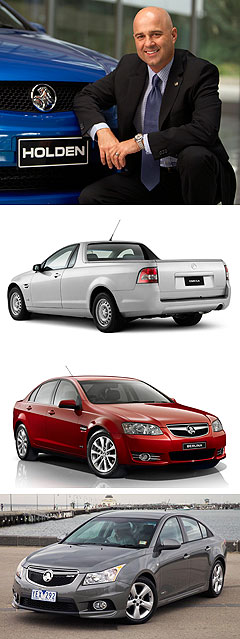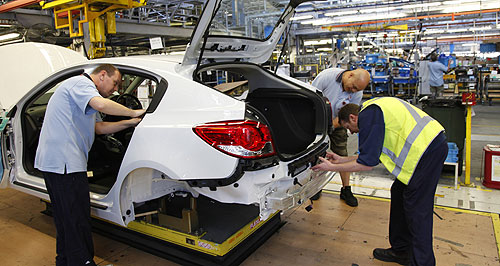Make / Model Search
News - HoldenHolden cuts jobs as D-day nearsStaff cuts: Holden will cut more than 100 jobs at the Elizabeth plant in South Australia - most of which are on a temporary or contract basis. Major announcement on car industry future “in 60 to 90 days” as Holden cuts jobs2 Feb 2012 GM HOLDEN’S future as an Australian manufacturer might be decided within a month, with the company foreshadowing an announcement on its talks with the federal government over potential taxpayer co-investment in its local manufacturing operation to ensure a new generation of Aussie Holden cars. The announcement timing was revealed today when Holden became the second Australian car-maker in a fortnight to cut jobs, as the dollar-battered local industry reels from falling exports and the poorest January sales of locally built large cars in memory. More than 100 jobs will go at Holden’s Elizabeth plant in South Australia, through natural attrition of permanent workers who quit and a culling of temporary and contract workers, as the company – which once had plans for an around-the-clock three-shift production cycle to meet huge export orders – returns from two shifts to one on its assembly line by the end of May. The job cuts come as Holden and its General Motors parent company in Detroit negotiate with federal and state governments in Australia over funding to entice the world’s biggest motor company to retain its manufacturing presence in Australia against strong headwinds. GM Holden chairman and managing director Mike Devereux said that in the absence of tariff protection enjoyed by other motor industries around the world, Australia needed co-investment by government to attract “hundreds and hundreds of millions of dollars” of investment in new-generation models and plant.  Left: Holden Chairman and managing director Mike Devereux. Below: Holden Ute, Commodore and Cruze sedan. Left: Holden Chairman and managing director Mike Devereux. Below: Holden Ute, Commodore and Cruze sedan.“That’s what the current negotiations with the government are all about,” he said. “I would say in the next 30 to 60 days we will have announcements to make in that regard … (announcements) that are very important for the long-term future of the manufacturing base in the country.” Federal ministers Greg Combet and Kim Carr today confirmed that the discussions with Holden about its long-term operations in Australia were continuing and that those discussions were close to being finalised. Industry and innovation minister Mr Combet said that the difficult situation being faced by all three Australian car-makers and the supply chain made it even more imperative to continue to support jobs in the local industry. Holden production at Elizabeth will be reduced by about 10 per cent, from the current 430-440 vehicles a day to 400 from a single morning shift, with the company saying the export sales recovery it had expected this year had been skittled by the high dollar that was sitting this morning at 107 Aussie cents to the US greenback. The news follows Toyota’s announcement last month that it would shed 350 jobs from its Altona factory in Victoria due to the high dollar, even though it had just started production of its all-new Camry. Official VFACTS figures out tomorrow will show that two of the three local manufacturers all suffered a shocking decline in sales of their locally made large cars in January, with the Holden Commodore sedan and wagon finding just 2170 new homes for the month – down almost 18 per cent on last January’s 2645. Ford’s refurbished Falcon sedan failed to achieve 1000 sales – a historical low. This raises questions about the potential for further job cuts at Ford’s Victorian factories, where 240 workers were shown the door last year, not to mention at struggling suppliers. Holden’s V6 engine plant, which exports two-thirds of its production to South Korea and China, is also facing tough times, and Holden says it has been reducing the workforce there through natural attrition. Mr Devereux said today that Holden had been gearing up to make at least 100,000 vehicles at Elizabeth this year, on the hope that exports to the Middle East would recover and that demand from US police forces for the Holden-made Chevrolet Caprice Police Patrol Vehicle (PPV) would grow. He said planning for 2012 had been based on a “dollar with a nine in front of it”, but with the Aussie dollar now at 107 cents, export predictions had been cut. “Thank God we have a business model in this country that does not rely on exports,” Mr Devereux said, perhaps referring to Toyota Australia’s business model with its high export dependency. Instead of 100,000-plus vehicles from Elizabeth, Holden now expects production to remain flat at about 90,000 units this year – the same as 2011. Mr Devereux said Holden would still export “thousands” of Caprice PPVs to the US, but admitted it would be well below the “five-figure number” that he had hoped due to high cost driven by the lopsided exchange rate. However, he said the program remained alive, and Holden would continue to ship PPVs to the US each month. Holden workers on the afternoon shift at Elizabeth were told of the latest moves last night. The afternoon shift workers who normally start at 2.30pm will be asked to join colleagues on the morning shift at 6.30am, with Holden planning to almost double the line speed from 104 seconds per car to 60 seconds. The afternoon shift – which will remain in other areas of the factory such as the stamping plant – will be gradually phased out in the general assembly plant, with workers moving alongside their morning counterparts. Specialist engineers will be brought into the plant to reconfigure the assembly line for the extra workers and higher operation speed, but Holden says it does not expect to have to spend money on new equipment. Holden is growing increasing dependent on its four-cylinder Cruze small car for throughput at the factory, with the Cruze sedan and hatch outselling the Commodore sedan last month, 2447 to 2170. Over the past decade, Holden has cut its workforce at Elizabeth by more than half as it battles to improve its productivity and compete against increasingly cheaper imports as tariffs have been cut to just five per cent – one of the lowest protection regimes of any car industry in the world. Last year, Holden said Cruze would secure 600 jobs, 265 of them in Elizabeth, as it built production up to 480 units a day on two shifts. Production had fallen to as little as 310 vehicles a day at the height of the global financial crisis, with workers sharing jobs week about to avoid redundancies. While manufacturing jobs are now openly being cut, a question mark hovers over Holden’s large design and engineering force based in Victoria. Mr Devereux today would only go as far as to say that Holden would do everything it could to make sure all those workers would be fully employed.  Read more2nd of February 2012  Market Insight: Falcon sales crash to all-time lowFord Falcon registrations hit record low in January as Commodore sales also slide23rd of January 2012  Toyota chops 350 jobs at AltonaStruggling Toyota slashes 10 per cent of Camry plant workforce, despite new model23rd of November 2011  Get free-trade deal right this time: FCAIMotor industry peak body flags danger signs in Pacific free trade proposal |
Click to shareHolden articlesResearch Holden Motor industry news |










Facebook Twitter Instagram